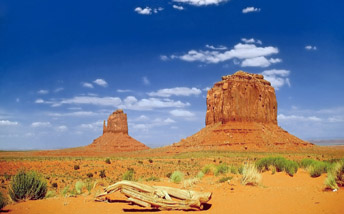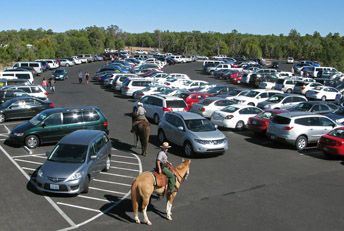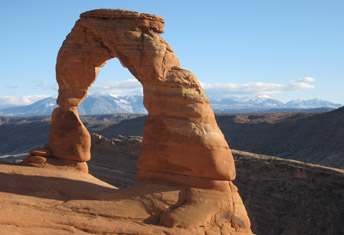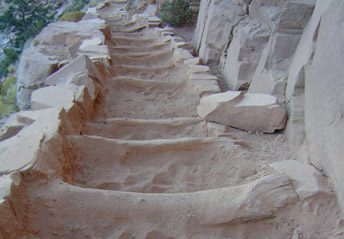Oct. 19, 2011 — It was an idea that has since been called “America’s best,” and it was radical for its day: set aside the most majestic and important spaces in the country so that they would be preserved for coming generations, made accessible for all Americans, and serve as a living laboratory of, and testament to, American history. There are still staunch and enthusiastic supporters of the parks — both within the National Parks Service and outside. But there are also regular reports of the constraints impeding the ability of the Parks Service to meet its mission, and anxiety that the parks have become, or might become, irrelevant to the majority of Americans.
The agency and its supporters are focused on developing creative plans to cope with chronic underfunding. In their effort to make ends meet, however, bigger dreams have gotten lost. In the quest for adequacy, virtually no one is asking — and fewer are prepared to answer — the question of “what could we do to make our parks excellent?” Could we enhance the vision so that we run a system that meets its fullest potential?
Early vision
When Congress passed the Organic Act of 1916 establishing the National Park Service (NPS), it provided that the new agency would preserve the parks and make them accessible for public enjoyment while still leaving the natural beauty and distinctive grandeur of each unimpaired. “Congress never described what ‘leave unimpaired means,” however, says Dwight Pitcaithley, a former NPS chief historian. “It’s been a struggle ever since to figure out what that means.” He suggests that to get a better idea of the original vision, we look at the words of the early park promoters.
“I think the essential vision was first of all to preserve them from destruction by private entities for tourist purposes or mining, destroying them in large industrial ways. And two, to provide enough accommodation — and enough is the key word here — so that people could spend a couple of days or a week in the parks to appreciate what makes them significant.”
“We may be the only federal agency that has ‘enjoyment’ in our fostering legislation,’” David Barna, chief spokesperson for the Park Service, adds, explaining that fostering the experiences of leisure, relaxation, and a sense of the wonder of nature for the general public “were of paramount importance in the creation of the National Park Service and are still important today.” Behind the creation of NPS was a belief that places of grandeur, contemplation, and relaxation should be available to all Americans — both to maintain a collective history and to encourage an engaged and healthy citizenry.
A history of ups and downs
In the years after the Organic Act of 1916, the parks were expanded significantly. In the 1930s, historic landmarks such as military sites and national monuments were brought under the umbrella of NPS, and infrastructure — such as roads, bathrooms, and hiking trails— was increased during the New Deal.
Though the parks deteriorated during the lean budget years of World War II and into the 1950s, they experienced a renaissance in the 1960s. Between a burgeoning environmental movement and “Mission 66” — a ten year initiative to increase the funding, infrastructure, and quality of the NPS — the parks thrived.
In the early years, railroads had brought visitors to Western parks that were remote from urban areas, but these opportunities were only available to wealthier Americans. In the 1960s and 1970s, the interstate system opened park access to a larger percentage of the population, and the number of visits swelled.
The Reagan years and their aftermath
The period of plenty ended with the Reagan administration. Michael Kellett, director of the New National Parks Project, an organization devoted to encouraging the creation of new national parks, says that the Reagan years were dark ones for NPS — and that the legacy of those years still reverberates today. “The main problem with our existing parks is that NPS has been starved in terms of budget and morale [ever] since Reagan [when it was] battered and abused.”
“When James Watt came along [as Secretary of the Interior], he cut the budget and put on caps, basically told the Parks Service, ‘We don’t want to hear from you about expanding parks; it’s the business of Congress,’” says Kellett, adding that, since that time, “A lot of people with vision have left the National Parks,” and the technological capacity, “has been gutted.”
A vast system — but how healthy?
Today, the Park Service includes 394 park units — which range from national historic sites like the home of Franklin Delano Roosevelt to recreational areas like the Delaware Water Gap National Recreation Center to the large and scenic parks like Acadia and the Grand Canyon that are most frequently associated with the National Park Service.
According to the National Parks Conservation Association (NPCA) the park service includes 7,600 public and administrative buildings, 680 water and waste systems, 12,000 miles of paved and unpaved roads, 26,000 historical structures, and more than 121 million museum specimens and artifacts. In fact, the Park Service oversees more artifacts than any other federal agency — even the Smithsonian.
Some indicators might lead to an optimistic prognosis for the parks: park visiting rates are high, and current funding is 10 percent higher than in the last year of the George W. Bush administration. In anticipation of the centennial of the parks in 2016, NPS Director John Jarvis has proposed a Call to Action for a Second Century of Stewardship, a report that outlines a strategy for the parks, emphasizing outreach to the American public, education, preservation, and innovation.
But status reports from park advocates are mixed. Richard B. Smith, a member of the executive council of the Coalition of National Park Service Retirees, says that the parks “are in remarkably good shape” for the number of visitors that they get. “But,” he adds, “It’s getting tougher and tougher,” to maintain them.
In recent years, some parks have been criticized for overcrowding. But while Smith suggests that the problem of overcrowding may be overstated — “Once you get off the road,” he says, “unless you walk the most popular trail in the world, you’re going to be alone” — he does point out that the enormous growth of the population of the United States since the founding of the large parks has created a difficult challenge. Whereas there were approximately 500 visits to Yellowstone in the first year of the Parks System, Smith says, Yellowstone now hosts 3 million visitors a year. He notes with some understatement, “Conditions have changed.”
Conditions have changed in other ways as well. The parks are subject to invasive species, failing sewage systems, underfunding, and a deferred maintenance backlog of almost $9 billion. “The park service will never catch up,” says Pitcaithely. “And we’ll never know going into the park, because they keep the front part looking nice, painted and paved and all that, but you start noticing around the back part…that things are not as well kept [up].”
Experts, however, say that most people aren’t aware of these shortcomings because the park service does a good job of concealing them. “Visitors are largely satisfied with their visit, because the park service is incredibly good at robbing Peter to pay Paul,” says Picaithely.
“Cutting ribbon at a new visitor center is a great political theater,” Barna says, but there is less support for “repairing the sewage system at Yellowstone that badly needs [it].”
Every year, the park service experiences an operations shortfall of nearly $600 million. “They’re not the way they were in the beginning,” says James Nations, director of the Center for National Park Research, a branch of NPCA. “We’ve lost species in 90 percent of the parks, air quality is sub-standard, [and] we’re losing cultural resources because we don’t even have a good inventory of what we have.” Smith says that the parks are seriously understaffed: “Many parks have huge numbers of vacant positions that they can’t fill [due to budget constraints]. When you don’t have the people, you can’t do the job. We’re no longer cutting fat; we’re cutting muscle and bone.”
Pitcaithely agrees. Asked what the Park Service needs for improvement, he answers, “We need more historians, more interpreters, archaeologists, biologists to maintain the intellectual integrity of the agency.” He would also like to see exhibits updated. Their average age is currently 20 years, but some are as old as 50.
And meanwhile, with resources stretched so tightly, there is little room for unforeseen events. For instance, when private land that exists within park boundaries comes up for sale, NPS often does not have funds available to purchase that land and enhance the integrity of the park. A few years ago, for instance, as Jeffrey Olson, a spokesperson for the Park Service recalls, private land use in the Black Canyon of the Gunnison in Yellowstone created a controversy. “People are probably still upset about it. Someone owned some really prime real estate in the park and was building trophy homes on it,” he said.
Tight budgets also prove problematic when natural disaster strikes. When a hurricane destroyed a visitor center in Jamestown, Virginia or when the Washington Monument was damaged in the recent earthquake, it was difficult for the Park Service to come up with the money for repairs. As Pitcaithley explains, “money wasn’t budgeted” to take care of emergencies.
Continuing relevance
More than a few park supporters are concerned about whether the parks will continue to appeal to a broad public.
“The biggest issue that the park service has right now is relevancy,” says Barna, “We’re the first to admit that, especially at the large scenic parks, that we are principally a middle-class Caucasian visit.” So attracting visitors from a broader range of socio-economic and racial backgrounds is a top priority of Director Jarvis’s “Call to Action.” He wants the parks to become more involved with local schools and preservation associations through initiatives like additional field trips in the parks and creating more partnership programs.
Many experts agree that the parks need to appeal to a larger audience. Accomplishing this requires expanding the Park Service’s educational lens beyond the history of white Americans, they say, creating new parks that focus on histories of under-represented groups. “We have not done a very good job of telling the story of Latin Americans in this country,” says Barna, continuing, “We have done an appalling job of telling the story of Japanese Americans.”
“We need a comprehensive plan for growth of the park system,” says Ron Tipton of NPCA, “We need a park system that represents the history and culture of this country.”
“If the parks aren’t relevant in the next 50 years,” Barna worries, “if the ethnic and cultural mix of America continues to change, and we don’t change to include everyone, people aren’t going to be willing to pay taxes to support national parks.”
There are a variety of other factors that, many say, mean the original vision of the parks as places of contemplation and recreation is at least as important today as it was a century ago, especially given the specific demands and conditions of a highly technological society. That parks preserve nature is important for two reasons, Smith says: one, for understanding the national history, and, two, for escaping some of the pressures of modern life. “If you think about both our natural and cultural parks, that’s where we find out who we are as a nation,” he says, “you get to see what America was and you get to experience nature unvarnished; you can unplug your iPod, turn off your cell phone, turn off your iPhone, and live life according to the rhythms of nature and not the pulse of economic or social rhythms.”
Barna agrees, saying that Americans need a break from the busy pace of urban life, that they need the leisure and exercise that founders of the park service thought were keys to a healthy and engaged citizenry, “the spiritual health of getting out into nature and getting away from the busy lives they lead.”
Adding to this, Kellett says, “There are more and more people in the U.S. and less and less open wild protected places. Everything that doesn’t get protected will be developed to the point where it loses value. Parks provide the strongest protections for the things that we really care about.”
“Is this a trick question?”
Remapping Debate tried to get a sense of what is actually needed for parks to fulfill a robust vision for their role in society — regardless of budgetary cost.
One issue is simply the logistics of getting Americans to the parks in the first place. An item on many wish lists is a comprehensive public transportation system inside and outside of the parks — a system that would not only cut down on emissions and pollution but also allow those who do not own a car access to large scenic parks. Many Americans live in areas that are far from the iconic parks of the west. Even for those who live close to national parks, access can still be difficult.
Tipton says, for instance, that when the NPCA was conducting research for the State of the National Parks study, Gateway National Recreation Center, some of which is actually within the borders of New York City, was extremely difficult to get to using public transport. When asked what he might do with an unlimited budget, Barna says, “That’s what the future is: how we move people.”
Smith says that with a larger budget, one practice he’d like to see the park service do is the very kind of reimagining that Remapping Debate was asking of him. “Those are the kind of exercises that you do when you have enough time and staff, but when your staff is entirely devoted to plugging the leaks in the dike, you don’t have time to do that kind of stuff.” He does add, however, that Jarvis’s “Call to Action” may be a good start. “I was proud to see him do it. It was the first time in a long time that I had seen a vision for the future come from inside the park service.”
Pitcaitley, after making sure that we were not posing a trick question, says that he dreams of seeing unparalleled professionalism and excellence in the parks. “They’ve got to be current, and there’s got to be a direct infusion of content — history, archeology, ethnography — into the interpretive and educational programs. We have to bring scholars into the parks.”
Doing so, he says, would facilitate a greater understanding of collective history and better equip the American public to make informed decisions. Pitcaitley acknowledges that these changes would be expensive, but says that they are necessary, among other things, to foster civic engagement.
Is anyone prepared to pay?
Some increased funding would need to go to cover deferred maintenance. NPCA, which had made 27 recommendations to restore the parks, estimates that it would take about $600 to $800 million more a year just to bring the parks back up to working order.
Pitciathley’s estimate is higher: “Danny Galvin [a colleague and retired deputy director of NPS] and I wrote that we thought a healthy budget would be somewhere in the five to six billion dollar range, which is more than double its budget now.” That amount would enable the park service to address its maintenance backlog of nearly $9 billion and “maintain what congress requires it to maintain, and that’s both in landscapes and in historic objects.”
As for the money involved in the task of creating new national parks, no one seems to know how much it would really take, let alone where it might come from. Each park is different, so there is no recipe for determining cost.
Sen. Tom Carper (D-Del.), for instance, has proposed a new park, which would be comprised of a network of sites across Delaware that includes places related to early Dutch and Swedish colonization and to the events leading up to the signing of the state constitution. He says the cost will be approximately $6 million, which he characterizes as minimal . Some parks, however, can cost over ten times that amount depending on different factors, including how much land must be purchased and the infrastructure that would need to be built.
In general, Carper says, Congress is skeptical of providing additional funding for the purpose of creating new parks.
“There’s a belief that the park service today has more will than wallet, if you will, and that they lack the resources to take care of parks that are already in their tender loving care,” he says. Carper says that he believes that parks are worth paying for, but not if it increased the national debt.
For Pitcaithley and Smith, however, the situation is more pressing, “Our history is, in a sense, our civic glue, and we ignore our history collectively at our own peril,” says Pitcaithely.
“These are places that are so much a part of the fabric of our society, that it’s hard to imagine that we would be the same as a people without them in public ownership,” Smith adds with a sense of pride.
And what does it say about us as a society if we neglect these places? “One super bomber costs almost as much as the entire budget of the national park service,” Smith notes. “So what are our priorities?”



